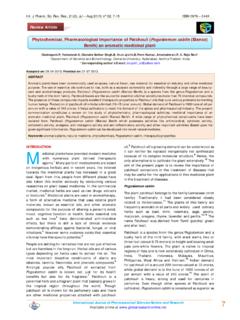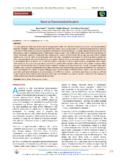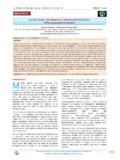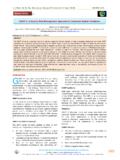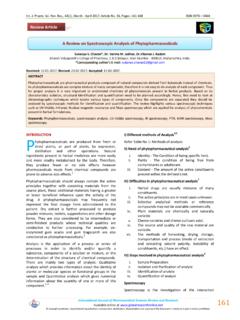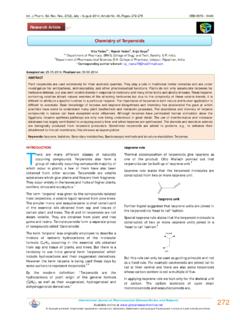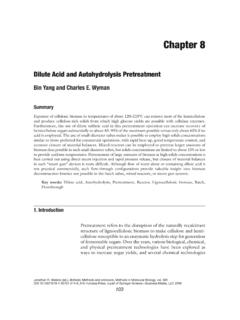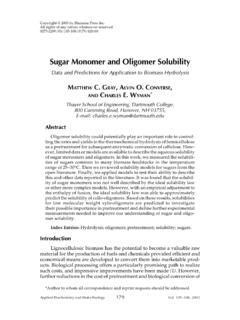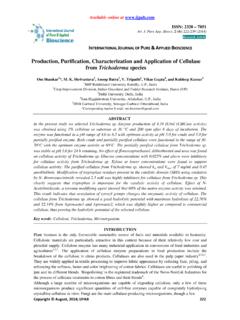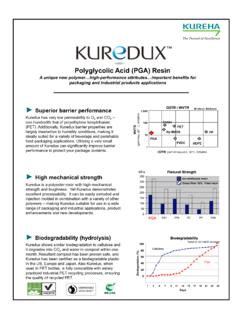Transcription of Physico-Chemical Properties of Microcrystalline …
1 Int. J. Pharm. Sci. Rev. Res., 29(2), November December 2014; Article No. 02, Pages: 5-9 ISSN 0976 044X. Research Article Physico-Chemical Properties of Microcrystalline Cellulose Derived from Indian Bamboo (Bambusa vulgaris). 1* 1 1. Umeh Ogochukwu Ngozi C , Nworah Augustine Chizoba , Ofoefule Sabinus Ifeanyichukwu 1. Department of Pharmaceutical Technology and Industrial Pharmacy, University of Nigeria, Nsukka. *Corresponding author's E-mail: Accepted on: 05-08-2014; Finalized on: 30-11-2014. ABSTRACT. The high demand and importance of Microcrystalline cellulose used in pharmaceutical industries has led to the utilization of locally and naturally occurring materials in the production of Microcrystalline cellulose. In this study, the physicochemical Properties of a locally produced Microcrystalline cellulose derived from premature stems of sprouts of Indian bamboo (Bambusa vulgaris) coded MCC-BV was evaluated and compared with a commercial grade (Avicel PH101).
2 MCC-BV was prepared from the partial acid hydrolysis of -Cellulose obtained through a pulping process of the premature sprouts. The comparative Physico-Chemical Properties evaluated include: Particle size analysis, tapped, bulk and true densities; hydration capacity, moisture content and moisture sorption profile; the degree of polymerization and molecular weight. The cohesion and compactibility of MCC-BV were assessed and derived from the kawakita plots. The results obtained for these parameters are: moisture content ( ), hydration capacity ( ), swelling capacity ( ), degree of polymerization ( ), viscosity ( ) and average molecular weight 6. ( * 10 ). These results indicates that MCC-BV had a significantly (p < ) close resemblance to Avicel PH101 in terms of physicochemical Properties . Both MCCs showed the same organoleptic Properties , similar particle size distributions although the particle shapes or MCC-BV was different and it had poor flowability.
3 The overall results indicated that MCC-BV compared favourably with Avicel PH101 in terms of its Physico-Chemical Properties and complied with the specifications in the British Pharmacopoeia and Handbook for pharmaceutical excipient for Microcrystalline cellulose. Keywords: Microcrystalline cellulose, Indian bamboo (Bambusa vulgaris), Avicel PH101, physicochemical Properties . INTRODUCTION physicochemical Properties were compared with the best commercial grade of Microcrystalline , Avicel PH101. O ne of the most important requirements of a pharmaceutical excipient is its ability to comply with pharmacopoeial requirements, relating to purity, inertness and compatibility. Microcrystalline MATERIALS AND METHODS. Sodium hydroxide (May and Baker, England), Sodium hypochlorite (Jik, Reckitt and Colman Nig. Ltd.), cellulose (MCC), according to many publications is an Hydrochloric acid (Fisins, UK), Avicel PH101 (FMC.)
4 Excipient of outstanding merit and remains the most Corporation, USA), Distilled water (Lion water, Nsukka, widely used direct compression excipient serving as a Nigeria). Premature stems of sprouts of Indian bamboo strong dry binder, tablet disintegrant, an absorbent, filler (Bambosa vulgalis) were collected from Nimo in Anambra or diluent, a lubricant and MCC, a purified state, Nigeria and the MCC-BV was prepared in our alpha cellulose, has been widely used as an additive for laboratory. All other chemicals used were of analytical direct compression because of its good flowability, 2-4 grade and water was double distilled. compactibility and compressibility. Ofoefule and Chukwu examined Cissus gum blend with the Extraction of Alpha Cellulose Microcrystalline obtained from India bamboo in the The MCC-BV was prepared from the partial acid formulation of zinc oxide and sulphadimidine hydrolysis of -Cellulose obtained through a pulping Bambusa Vulgaris (Poaceae) is a perennial process of sprouts of Indian bamboo; a modified method plant found mostly in the all the southern parts of Nigeria used by Baichwal et al and Gupte et , 8-9 Simply, the except Lagos and from literature reviews in America and green bark of the Indian bamboo was peeled off, cut into It is known for its ability to check erosion as well chips and dried.
5 750g of the cut chips was macerated as its tensile strength for construction in It has overnight with of ethanol ( ) at room been used in paper making. The extracts has been used to temperature and the ethanol decanted. This was replaced treat inflammatory conditions; the resin has been known with L of sodium hydroxide and digestion to have astrigent, expectorant, constipating, cardiotonic, affected for 4hr at 100 0C in a sand bath. This step haemostatic, aphrodisiac and diuretic The removes lignin in the form of soluble complexes. stems sheaths has been used as covers for As Following thorough washing, the material was further part of on-going efforts to develop local raw materials for treated with 2L of sodium hydroxide at 100 0C for 2. pharmaceutical industry, we have in the present work hrs. The resulting -cellulose was neutralized to pH of 6. obtained Microcrystalline cellulose from the dried stem with acetic acid, bleached with 2L of sodium bark of Indian bamboo (Bambusa vulgaris) and the International Journal of Pharmaceutical Sciences Review and Research Available online at 5.
6 Copyright protected. Unauthorised republication, reproduction, distribution, dissemination and copying of this document in whole or in part is strictly prohibited. Copyright pro Int. J. Pharm. Sci. Rev. Res., 29(2), November December 2014; Article No. 02, Pages: 5-9 ISSN 0976 044X. 0. hypochlorite for 30 min at 50 C and washed with water. as the tapped volume. The tapped density was calculated The extraction process was completed by whitening with using the formula: sodium hypochlorite for 30 min at 500C and washing ( ). with water until neutral. The cellulose material was = (2). ,( ). filtered, pressed and manually reduced to small lumps which was dried in a fluidized bed drier (Copely True Density laboratory model, England) at an in-let air pressure of 40- The densities of the cellulose powders were determined 450C for 4 hr. by the liquid displacement method using kerosene as the 15. Preparation of a grade of Microcrystalline cellulose from immersion fluid.
7 Indian Bamboo Hydration capacity and Swelling capacity of the -cellulose obtained was further treated by a The principle of Kornblum and Stoopak16 was used to process reported by Corey10 with 2L of hydrochloric determine the hydration capacity of MCC-BV. A g of o o acid under vigorous stirring at 100 C 2 C for 30 min. The MCC-BV was each placed in four 15 ml plastic centrifuge resultant powder mass was bleached with w/v tubes and 10 ml of distilled water was added and solution of sodium hypochlorite and washed with water. stoppered. The content was agitated for 3 min, allowed 0 o The final product was dried at 60 C C using a to stand for 10 min and immediately centrifuged using a fluidized bed drier and pulverized with an end runner mill Gallenkemp bench centrifuge (Gallenkemp, England) at and passed through a 75 m sieve. 1000 rev per minute for 10 min. The supernatant was Physicochemical Studies carefully decanted, the stopper replaced and the sediment was weighed.
8 The organoleptic characteristics, identification, organic impurities and solubility were done in line with BP The hydration capacity was calculated using the formula: An optical electronic microscope, Nikon ( )=.. (3). ( ). model Larphot2 (Nikon inc., Japan) was used for preliminary assessment of the nature of particles in MCC- Swellability BV. A combination of both low and high power objective This was measured at the same time as the hydration lens of 100 and 400x magnifications was used. capacity determination using the method of Okhamafe et pH Determination: This was done by shaking 2g of MCC- BV with 100 ml of distilled water for 5 min and the pH of Compactibility and Powder Cohesion. the supernatant liquid was determined using a pH meter (Corning model 10, England) The cohesion and compactibility of MCC-BV were assessed and derived from the kawakita plots17 by POWDER Properties AND MICROMERITIC STUDIES.
9 Determining the tapped density and the behavior of MCC- Particle size analysis BV during the tapping process. Test sieves ranging from to 25 m were arranged in A g quantity of the sample was poured into a 25 ml descending order with a collector pan underneath the measuring cylinder and leveled with a thin metallic shaker. A 20g quantity of MCC-BV powder was placed on spatula and the bulk volume (V0) was measured. The the top sieve and was shaken for 5 min using an cylinder was mechanically tapped and values of the Endicott's sieve shaker (Endicott's Ltd., UK). The weight of volume, V of the powder after N number of taps were the material retained on each sieve was determined. measured. Bulk and Tapped Density The process was repeated and the values V and V0 were used to calculate the degree of volume of reduction. A 50g quantity of the MCC-BV powder was placed in a 10. ml measuring cylinder and the volume occupied by the The cohesion and compactibility of MCC-BV was material was noted as the bulk volume.
10 The bulk density calculated using the following kawakita equation for was obtained by dividing the mass of the material by the powder densification: bulk volume as shown in Equation 1:12-14. = + 1 .. (4). ( ). = . (1). ,( ) . The cylinder was tapped on a wooden platform by dropping the cylinder from a height of one inch at 2 1/b describes the cohesiveness of the powder and a, is seconds intervals until there was no change in volume considered to be the compactibility of the powder. reduction. A graph of N/C against N gives 1/a as the slope and 1/ab The volume occupied by the material was then recorded as the intercept. International Journal of Pharmaceutical Sciences Review and Research Available online at 6. Copyright protected. Unauthorised republication, reproduction, distribution, dissemination and copying of this document in whole or in part is strictly prohibited. Copyright pro Int. J. Pharm. Sci. Rev.

